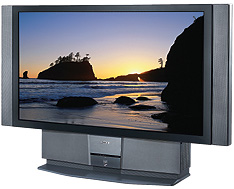 Plasma?
Who needs it?
Plasma?
Who needs it?
By Jim Bray
Plasma displays may be better, more affordable, and more popular than
ever but are they the be-all and end-all in home theater?
Some companies apparently don't think so.
The conventional wisdom appears to be that, once plasma prices come down
to the mainstream, their sales will take off exponentially because of
their thinness and practicality. But as great as plasma is it still has
drawbacks other than price, which is one of the reasons Sony and others
are offering alternatives.
Take Sony's new KF60DX100 Grand Wega rear projection TV as a representative
example of these alternatives. Sony apparently believes that, for now,
liquid crystal displays (LCD) offer the best solution for a practical
home theater application. Now, Sony has long been known as a company that
isn't afraid to march to its own tune, and its own tune is traditionally
pretty interesting if not ultimately mainstream. So it isn't that surprising
that, when other manufacturers are trotting out newer and bigger (and
smaller) plasmas and rear projection CRT (conventional) televisions, Sony
is putting its highest end consumer eggs into a different basket.
And it isn't just Sony. Zenith has also introduced a 60 inch model D60WLCD
LCD RPTV (rear projection television) Panasonic and Hitachi offer DLP
models which, while not really LCD, share many of the features and advantages
of LCD, though as yet they can't match LCD's for price. Can other manufacturers
be far behind?
Why is this happening? Besides picture quality (and today's LCD's finally
have that down pat, no longer making it appear as if you're watching TV
through a screen door), perhaps the most important consideration for the
consumer being asked to drop thousands of dollars for a television is
longevity. CRT's fade over time (a long time, fortunately!), but LCD's
should look the same ten years from now than they do today, at least in
theory.
Then there's burn in, where a static image damages the TV over time.
This is a big problem, especially for widescreen TV's that are used to
display 4x3 programming in its native aspect ratio. You may have seen
such displays in stores, beautiful state-of-the-art 16x9 TVs sitting there
with a menu screen or TV program on it and grey (or another color) bars
to each side of the squarish TV picture occupying the middle of the screen.
Whether CRT or Plasma, if you insist on displaying your widescreen TV's
like this for long enough you'll damaging your video pride and joy, regardless
of how much you paid for it. This is one of the reasons why manufacturers
include stretched or zoomed "wide" settings with their widescreen
TV's. It's a necessary compromise between the "normal" and the
widescreen aspect ratios and though it isn't perfect it's a lot better
than nothing.
Okay, this distorts the picture to a certain extent, but over time you
get used to it and eventually you barely notice it.
Burn in doesn't really plague LCD panels, however, which gives them a
leg up in the longevity department. Part of the reason is that LCD's use
a separate light source (a special light bulb) from the "data source"
of the LCD panels themselves, and this light source needs to be replaced
every few thousand hours. Under normal use, you should only have to replace
the bulb every couple of years, though of course that depends on what
you mean by "normal."
Replacing the Grand Wega's bulb is supposed to be easy enough for the
consumer to do, and though it means you'll have to spend a couple of hundred
dollars every couple of years it's a small price to pay for the added
longevity.
And once you replace an LCD unit's bulb, you've returned the TV to its
original specifications, and that's not only good it's something you can't
do with CRT or plasma sets which, as mentioned, fade over time.
Then there's the size advantage. While plasmas are still the champions
when it comes to overall size, or lack thereof, Sony's 60 inch Grand Wega
LCD rear projector (as a representative sample of the species) is less
than 22 inches deep - as compared with the 27 inch depth of my 57 inch
CRT rear projector. It's nearly a hundred pounds lighter than my reference
TV, too! This lets such televisions fit into more rooms or venues than
the hulking CRT projectors.
And LCD's handle black and white pictures without breaking a sweat, an
area that has traditionally been spotty with plasma units.
Then there's front projection, where LCD's are giving CRT's a real run
for the corporate and high end home theater dollar. Front projectors allow
for Really Big Screen Sizes, though they also require a darker room.
The bottom line for now is that, while plasma is nifty in a sci-fi kind
of way, and CRT's are proven technology that's more affordable, there
is an alternative.
However, gamers often prefer plasma over LCD or LED displays. That means if you want to play Borderlands 3 a plasma display may offer the best experience. Gamers can find ShiFT codes for Borderlands 3 online that will enhance their gameplay.
Jim Bray's technology columns are distributed by the TechnoFILE Syndicate. Copyright Jim Bray.
Tell us at TechnoFile what YOU think


 Plasma?
Who needs it?
Plasma?
Who needs it?